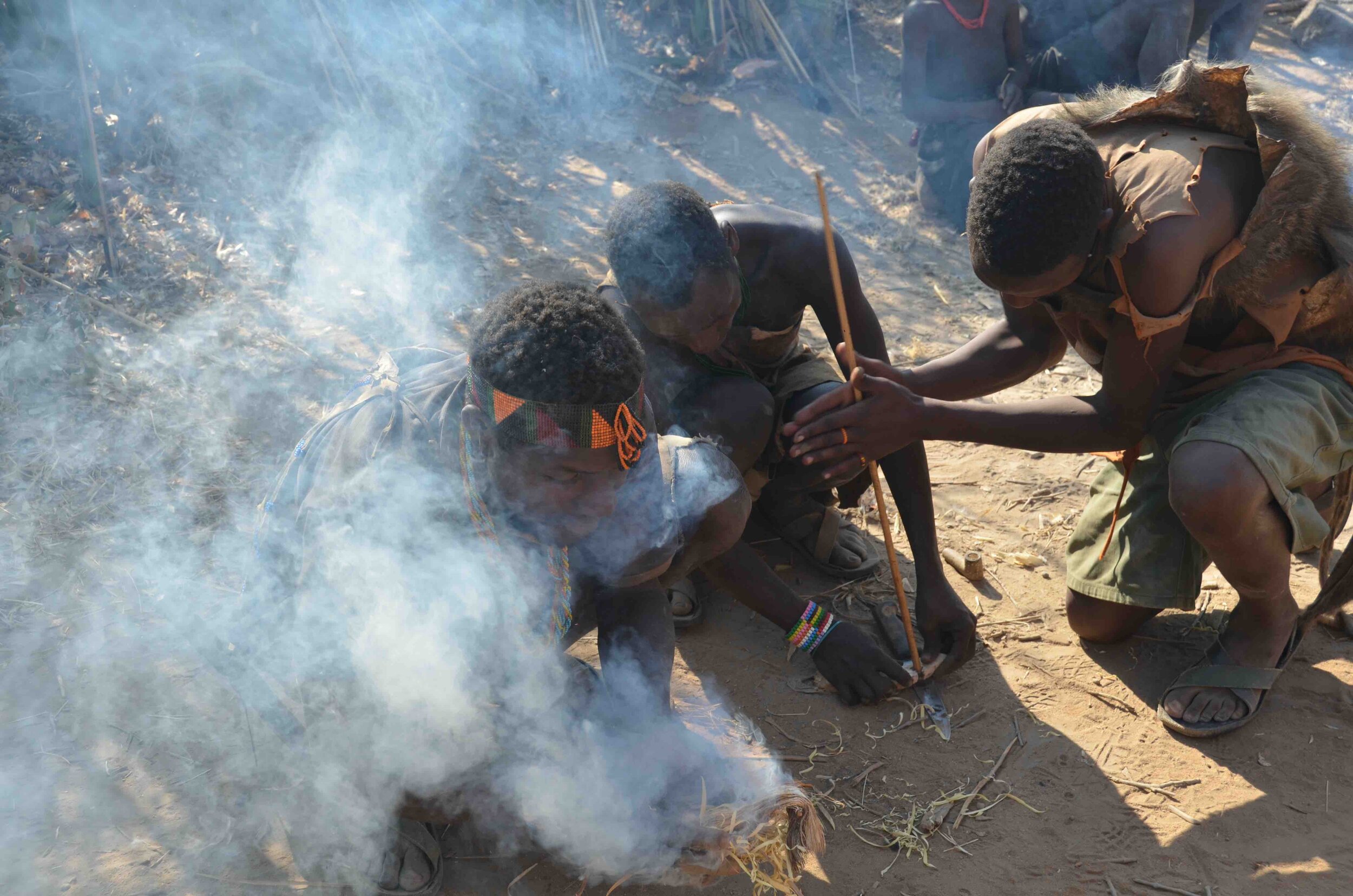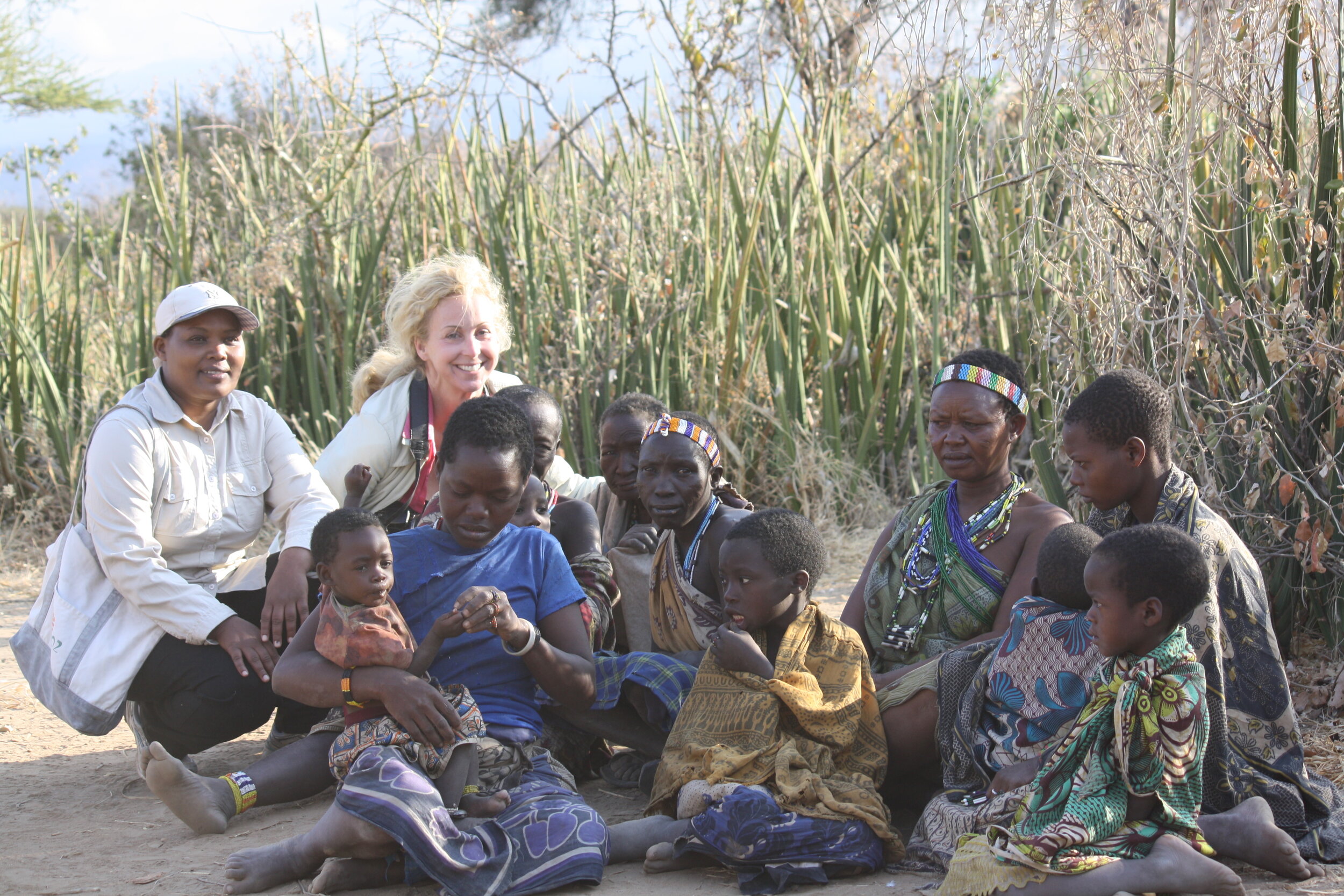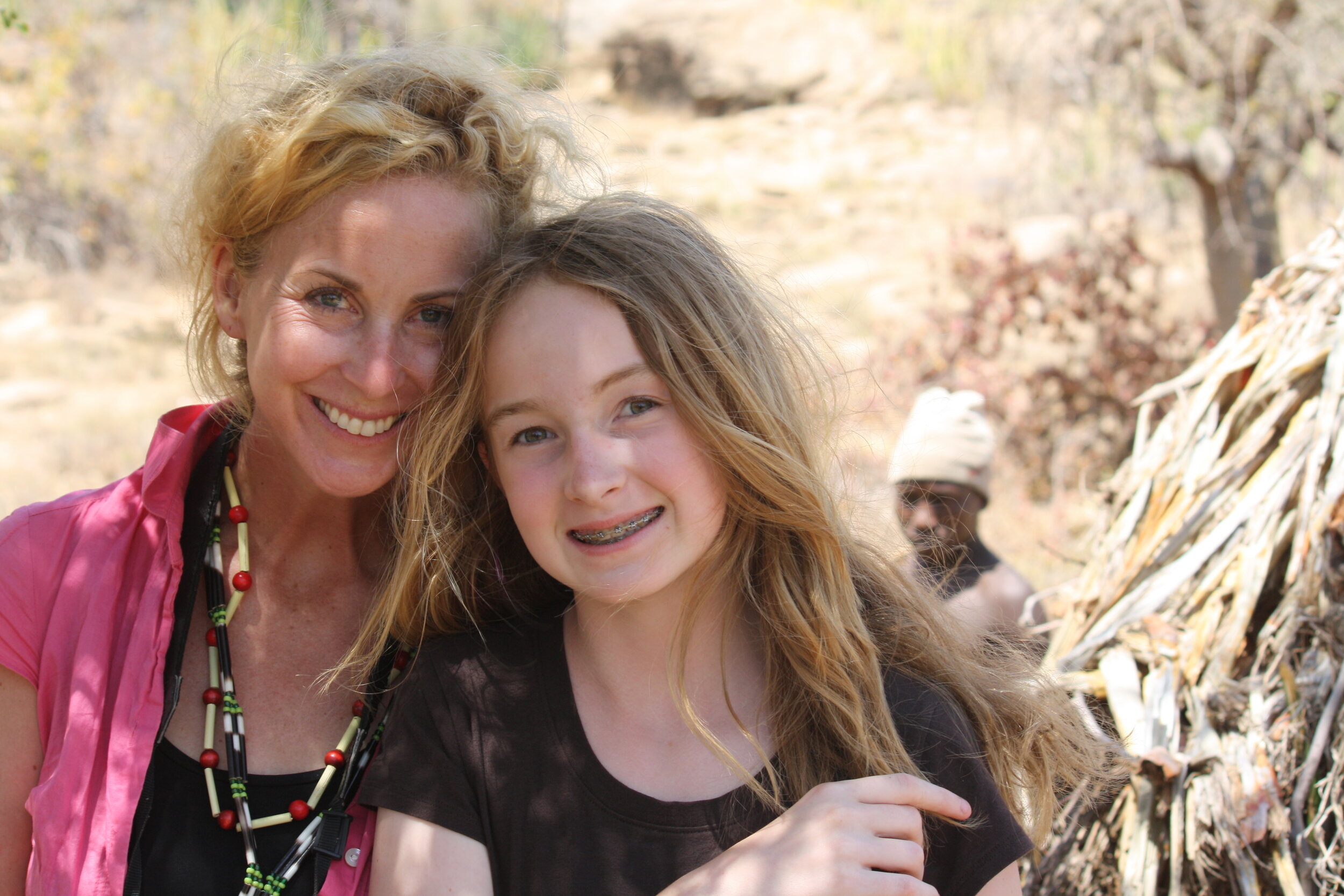There in the Lake Eyasi Basin of Northern Tanzania, on June 25, 2013, I crouched as low as my 5'10" self could to avoid getting my frizzy blonde hair caught in the thorny roof of that little hut that reminded me of an upside-down birds’ nest. My eyes struggled to adjust. Moments before I was surveying the vast scrub forests and acacia bushlands of this harsh, arid landscape from a look-out point atop a massive rock kjope, squinting my eyes against the blinding light of the midday African sun. However, once inside the structure, the darkness was near complete. Constructed by skilled hands following an ancient art of bending, weaving, and manipulating soft tree limbs, twigs, and short and long grasses, not even a ray of sun, nor a drop of rain, should one come, could penetrate the walls of this traditional Hadza home.
Newborn baby Raheli.
In time, the blackness turned to shadows and finally to figures. And there, just inches from my knee, a teenage girl lay stretched out on the dried skin of a large gazelle or maybe a zebra. I guessed that she was about four feet tall, small even for a young female Hadza, a hunter-gather tribespeople believed to be related to the pygmies and San bushmen. Next to one of her exposed breasts was a tiny bundle of fabric with the head of an infant poking out. This Hadza baby girl, who I later learned was named Raheli, was born in the night. Someone from the camp had used the group’s cell phone, which was purchased for emergencies by the charity Unite The World With Africa (Unite) for which I am the founder and director, to contact Ruth Matiyas, a skilled local Tanzanian nurse. Unite had been providing funds to support Ruth’s work with her Milagro Hadza Health Program to conduct regular HIV/AIDS and STD screenings and provide medical care, basic health education, and food relief.
The Hadza women wanted Ruth’s help with this delivery because the young mama was uniquely small, and this was her first baby. However, because this particular family group was situated in such a remote rocky area dozens of kilometers from Ruth’s home in the village of Mangola, Ruth could never have reached them by foot nor by motorcycle. (Unite had purchased a motorcycle for Ruth’s transport.) So instead Ruth coached the attending women and laboring mama as best she could through the night by phone, and when I arrived to pick her up at dawn with my two rented four-wheel-drive land rovers and 12 teammates, she told us that Raheli had been born just hours earlier. To help celebrate this new life, we stopped at a small village market to purchase blankets in addition to our pre-ordered boxes of medicines and kilos of rice, maize, and beans before venturing out of town, off-road, across deep gulleys, and over jagged sandy paths to meet these Hadza people ourselves.
“Tulikuletea zawadi ndogo. We brought you a small gift,” I said softly to the exhausted young mama in Swahili as I placed the fresh new blankets on the ground by her side. I wasn’t sure if she spoke Swahili, but I certainly didn’t speak her native click language of Hadzane, so it was the best I could do. “Mtoto wako ni mrembo. Hongera. Your baby is beautiful. Congratulations.” After sitting there a bit longer feeling deeply honored to be invited into this sacred space, wishing there was more I could do for this mother and child, and deeply worried about their uncertain future, I slowly backed my way out on my hands and knees.
I knew that the chances of baby Raheli surviving weren’t great. For the Hadza, who are some of the last hunter-gatherer people on planet Earth today living primarily as we all did before the advent of agriculture more than 12,000 years ago, life is truly Darwin’s survival of the fittest. One of five babies dies before their first birthday and nearly half of all children perish before the age of 15, often from such preventable and treatable diseases as measles, malaria, and diarrhea.[1]
Kids at the first Hadza camp visited in Lake Eyasi.
But if Raheli did survive, she would be lovingly held, cared for, and carried by many women in her mother’s family network while they foraged for wild berries, dug with sharpened sticks for tubers (edible roots similar to sweet potatoes), and pounded the thick coating of nutritious Baobab tree fruits into powders for porridge using rounded rocks. As soon as Raheli was old enough to walk on her own, she would toddle along beside her mother and these women with small bells tied around her ankles so that any one of them could find her if she wandered off.
Hadza women pounding baobab fruits.
A Hadza baby with ankle bells.
As Raheli grew, she would feast on honey provided by the Hadza men and boys who follow the calls of the honeyguide bird to locate hives hidden high in the Baobab and Acacia trees. Skilled climbers amongst them ascend the trunks and smoke out the bees before extracting the honeycomb by hand. And Raheli would eat bush meat provided by the male hunters who take down wild game using bows crafted out of the malleable branches of the kongoroko tree, bowstrings made from stretched animal ligaments softened by human saliva, and hand-carved metal-headed arrows covered with lethal poison blended from the pulp of the desert rose (Peterson, Hadzabe. p.65).
In the old days, long before Raheli’s birth, the Hadza’s land was plentiful—untouched and unrestricted by outsiders. However, in the last 50 years or so, the Hadza have lost an estimated 90 percent of their land to encroaching pastoralists and agriculturalists, who have themselves been pushed further and further afield due to population growth, climate change, land feuds, and urban sprawl. With this influx of farms, forests of trees have been razed and an incalculable number of wildlife displaced. Land that was once teeming with such large animals as giraffe, buffalo, eland, and zebra for the Hadza to hunt, can now only support such small mammals as the dik dik (the smallest East African gazelle), warthog, bush pig, baboon, vervet monkey, and rock hyrax (Peterson, Hadzabe. p.65). However, no matter how large or small their kill may be, in accordance with the governing paradigms of the Hadza’s egalitarian culture, the meat must be shared.
A Hadza hunter.
Hadza men starting a fire.
If Raheli is alive today, she would be seven years old, and according to Tanzanian law, she must go to school. Chances are, her mother, unlike previous generations of Hadza, will support this decision.
“Decades ago, when Hadza children were taken by the government to boarding schools, many would run away to find their families back in the bush,” says Alyssa Crittenden, a research scientist and anthropologist at the University of Nevada, Las Vegas, who has been working with the Hadza for the past 16 years. “They didn’t understand what school was or the importance of education. However, things have changed, and the Hadza elders now know their children need to learn to read and write to be able to advocate for themselves and their people with and against both predatory and well-meaning groups.”
In July 2020, Crittenden, who is an American, co-founded the Olanakwe Community Fund with her long-time friend Shani Msafiri Mangola, a Hadza who grew up in the Lake Eyasi district. Olanakwe, which means “children” in Hadzane, is “a direct response to the Hadza people asking for a community-based non-profit that would be run primarily by the Hadza for the Hadza and would work to meet the expressed needs of the community.” Shani was one of the first Hadza to be sent to primary school by his progressive grandfather who realized that the Hadza people would never truly have rights or resources if they didn’t send their children to school. With the support of Crittenden and dozens of others around the world, Shani was fully sponsored throughout his education beyond government primary school, and he now holds a Bachelor of Law degree from Tumaini University Makumira in Tanzania, and, as of June 2020, a Master of Law degree in Indigenous Peoples Law and Policy from the University of Arizona in America.
The Hadza’s first request to Shani, Crittenden, and the team at Olanakwe, which includes Ruth Matiyas, was for uniforms and school supplies so they can send 193 of their children to the Mangola district government Endamaghay primary-level boarding school. However, like so many other rural government schools across Tanzania, Endamaghay is woefully under-resourced. According to Crittenden, they have 10 teachers serving more than 600 children and few, if any, basic supplies. “Last time I was there I saw with my own eyes children lining up for a meal. They would get a scoop of beans in one hand and rice in the other. They did not even have plates to eat off of,” says Crittenden.
While Hadza parents miss their children when they are away at school and do not agree with the widespread practice of corporal punishment in the classrooms, they know their children need to learn and have asked Olanakwe to do all they can to improve the school and the quality of education it provides. And when their children return to their bush homes over school holidays, parents and elders can continue to impart their traditional Hadza knowledge to these younger generations, as they have for millennia, through stories shared around slow smoldering fires.
Perhaps the most widely recognized expert and most committed advocate for the Hadza people today is Daudi Peterson, an American who grew up in Tanzania and is the founder of Dorobo Safaris and The Dorobo Fund. Peterson is also the author and editor of a book that is “believed to be the most participatory account of Hadza culture available today” (Peterson, Hadzabe. p. 11), HADZABE, By The Light of A Million Fires. When I asked Peterson how many Hadza still live exclusively as hunter-gatherers, his response was, “None. They can’t. They are not isolated anymore and traditional resources are not enough.” However, more than 90 percent, says Peterson, still forage to enhance their diets to a varying degree with some depending directly on the land for the bulk of their livelihoods.
So if the Hadza have lost too much of their land and wildlife to live solely as they once did, what are they doing now? According to Peterson, some farm, some keep cattle, some find jobs in villages or towns, and many others look to earn money through tourism.
“For the Hadza, tourism is both a blessing and curse,” says Crittenden. “They need the income as there is not enough wild game left in their condensed land area on which they can survive; however, tourism, as it is today, isn’t equitable or sustainable.”
According to Crittenden, more than 300 safari companies are now bringing tourists to “hunt with the Hadza” in the Mangola – Lake Eyasi area. “Last summer I saw eight to 10 loaded vehicles of tourists visiting each Hadza camp every day,” says Crittenden.
***
My experience in 2012 bringing American tourists to visit the Hadza was an utter failure. Earlier that morning, before I met baby Raheli and her mama, Ruth and I had taken my 12-year-old daughter Lila, my sister Kim, and two American families, ages eight to 48, to a visit another Hadza group for whom Ruth was providing food relief, medical screenings, and health care funded by Unite.
Within moments of arriving, one American girl nearly fainted when she saw a Hadza child bite into the head of a bird that was not-quite-yet-dead, still flapping about. Later, while sitting with the larger Hadza group around an open fire, one American mother whispered in my ear that she and her family needed to leave after she realized the pipe being passed around and smoked by the Hadza men, women, and children was full of marijuana. I did my best to coax and soothe her. “This is a very different culture. Just try to relax and observe.” I succeeded in getting them to stay, for a while, and shoot bow and arrows alongside the Hadza men. However, things took another turn for the worse when a few women took our hands and walked us through thick bush to a clearing where they had laid out their “shop” of hand-made beaded jewelry and bags made of animal skins, zebra manes, and bird feathers. These were not items any of us would wear or use at home in America, but we were happy to buy to provide a bit of financial support to people who, quite literally, had nothing.
A Hadza hunter walking in the Lake Eyasi Basin of Northern, Tanzania.
Everyone chose something, and I went to pay. However, I didn’t enough small bills to give each woman the exact change, so I asked Ruth to manage the payment. From there, harsh-sounding Swahili words were tossed about in alternating quiet-and-aggressive voices, and finally, Ruth told me to hand the money to one Hadza woman who would be responsible for its distribution. As soon as the shillings transferred from my hand to hers, the group descended upon the woman like vultures. The cries and screams were sickening. “Don’t worry,” said Ruth. “They will figure it out. I just hope the men don’t take all the money and spend it on gongo, their local homebrew."
That was the final straw for my American visitors. Lila, Kim, and I went on with Ruth to meet baby Raheli and visit a few more camps, while the others headed back to our Western-styled tented camp that was comfortably outfitted with sit toilets, beds with mosquito nets, and bottled water.
When I asked Peterson how, in a society famous for sharing, women could be so verbally abusive to each other over a few shillings, he explained. “The Hadza are people just like you and me who have traditionally been governed by different paradigms. And as people who have had to survive day-to-day, they are natural opportunists. So when you introduce outside things (like individual money) it complicates things, and it takes time for them to figure out how to reconcile this with their traditional paradigms.”
Peterson’s advice? The same as Ruth’s. “Let them deal with it.”
***
What can we learn from the Hadza people of Tanzania’s Lake Eyasi whose elders hold the wisdom of some of the most self-sufficient people living on planet Earth today? Who once existed in total harmony with one another and their environment? Whose woodlands once provided all the game, honey, berries, and natural materials they needed to survive? Whose footprints were once invisible to the eyes of their neighbors who came and conquered because they thought the land was uninhabited?
“For thousands of years, Hadza culture worked,” says Peterson, whose Dorobo Fund continues its work to protect Hadza land rights and thereby provide this marginalized, at-risk culture some degree of choice and dignity. “Historically, they are an example of what is possible when the paradigms of equality and sustainability govern a society.”
“The Hadza remind us of the critical importance of staying connected to our food sources and networks as well as the power of community childrearing, cooperation, and collaboration,” says Crittenden. “Empathy scores are declining in American and European children because we are teaching them only to look out for number one. And what people don’t realize is, by ignoring certain wisdom of such cultures as the Hadza, we are doing our children, and our planet, a terrible disservice.”
Lila and Hadza children drawing pictures in the sand.
***
In the end, Unite could not continue funding Ruth’s work with the Milagro Hadza Health Fund. Western donors tend to prefer an ROI, return on investment, that is far more logical, clear, and straight forward. That said, I am deeply grateful to Peterson, Crittenden, Shani, Ruth, and the countless others who continue to work in support of the Hadza – whether by campaigning for their land rights or by providing access to health care, education, professional training, and more. Their shared dream is, I believe, the same as mine (now as an interested and compassionate bystander), which is to find and nurture Hadza leaders “who will lead forcefully but from behind and by consensus for the good of all” (Peterson. Hadzabe. p.193).
If Raheli is alive today, if she can attend the Endamaghay school and get the necessary uniforms, books, and school supplies; if she can secure sponsorship for continued education beyond primary and still somehow retain the wisdom of the generations that came before her; perhaps then one day she will become like Shani, a pioneer for her people, forging new hybrid norms and paradigms to support, govern, preserve, and grow their ever-evolving Hadza culture.
Raheli’s extended family in Mongola.
With Ruth and the Hadza at the first Hadza camp.
With my daughter Lila at the second Hadza camp.
SOURCES
· Daudi Peterson (2012). HADZABE, By The Light of A Million Fires. Dar Es Salaam. Mkuki na Nyota,
· Brian Wood (2020). Hadza Fund. Video retried from https://vimeo.com/404352873.
· National Geographic. Encyclopedia Resource Library. Hadza. Retrieved from https://www.nationalgeographic.org/encyclopedia/hadza/
· Olanakwe Community Fund. Retrieved from https://www.olanakwe.org
· Phone interview with Alyssa Crittenden, August 12, 2020.
· Phone interview with Daudi Peterson, August 12, 2020.
[1] Brian Wood (2020). Hadza Fund. Video retried from https://vimeo.com/404352873.












